Strategic Asset Management Plan for Cafe B - SITXFIN005 Task 3
VerifiedAdded on 2023/06/01
|29
|7245
|167
Report
AI Summary
This report provides a detailed analysis of Cafe B's asset management strategies, encompassing asset acquisition, implementation of the BMC asset management system, and planning for asset replacement. The acquisition section covers factors influencing asset procurement decisions, cash budget projections, depreciation methods, and supplier selection. The asset management section focuses on the BMC system, detailing its benefits and application for managing IT assets. The final section addresses asset replacement strategies, including cost analysis and decision-making processes. The report uses financial data and strategic considerations to provide a comprehensive overview of how Cafe B can effectively manage its physical assets to achieve its business objectives. Desklib offers similar solved assignments and past papers for students.
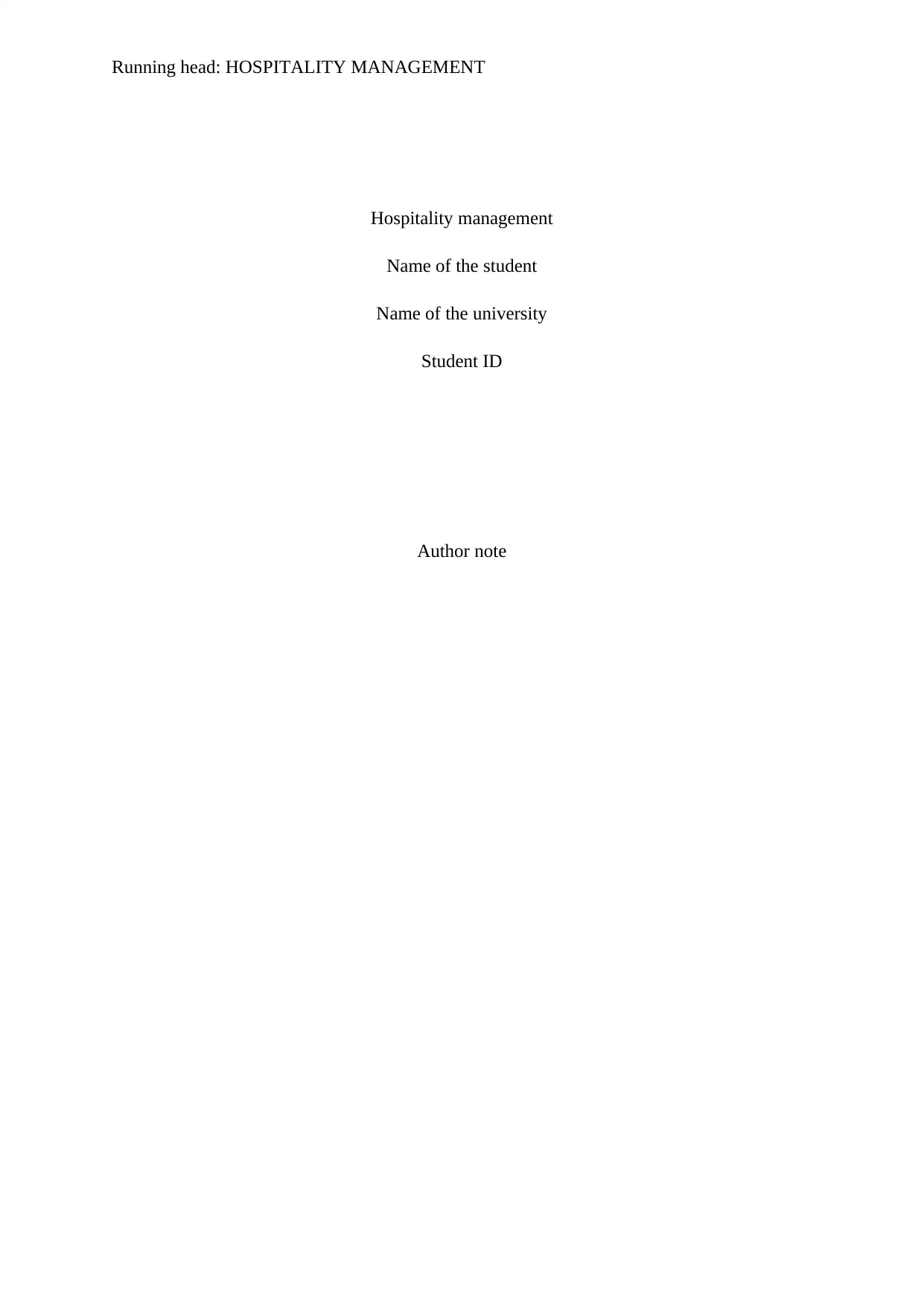
Running head: HOSPITALITY MANAGEMENT
Hospitality management
Name of the student
Name of the university
Student ID
Author note
Hospitality management
Name of the student
Name of the university
Student ID
Author note
Paraphrase This Document
Need a fresh take? Get an instant paraphrase of this document with our AI Paraphraser

1HOSPITALITY MANAGEMENT
Table of Contents
Section 1 – acquisition of asset..................................................................................................3
Part 1......................................................................................................................................3
Part 2......................................................................................................................................3
Part 3......................................................................................................................................3
Part 4(a)(i)..............................................................................................................................5
Part 4(b)(i)..............................................................................................................................6
Part 4(b)(ii).............................................................................................................................6
Part 4(c)(i)..............................................................................................................................7
Part 5......................................................................................................................................7
Part 6(a)(i)..............................................................................................................................7
Part 6(a)(ii).............................................................................................................................7
Part 6(a)(iii)............................................................................................................................8
Part 6(a)(iv)............................................................................................................................8
Part 6(b)..................................................................................................................................8
Part 6(c)(i)..............................................................................................................................8
Part 6(c)(ii).............................................................................................................................9
Part 6(c)(iii)............................................................................................................................9
Part 6(d)(i)..............................................................................................................................9
Part 7......................................................................................................................................9
Section 2 – Asset management system (BMC asset management)..........................................10
Part 2(a)................................................................................................................................10
Part 2(b)................................................................................................................................10
Part 2(c)................................................................................................................................11
Part 3(a)(i)............................................................................................................................11
Table of Contents
Section 1 – acquisition of asset..................................................................................................3
Part 1......................................................................................................................................3
Part 2......................................................................................................................................3
Part 3......................................................................................................................................3
Part 4(a)(i)..............................................................................................................................5
Part 4(b)(i)..............................................................................................................................6
Part 4(b)(ii).............................................................................................................................6
Part 4(c)(i)..............................................................................................................................7
Part 5......................................................................................................................................7
Part 6(a)(i)..............................................................................................................................7
Part 6(a)(ii).............................................................................................................................7
Part 6(a)(iii)............................................................................................................................8
Part 6(a)(iv)............................................................................................................................8
Part 6(b)..................................................................................................................................8
Part 6(c)(i)..............................................................................................................................8
Part 6(c)(ii).............................................................................................................................9
Part 6(c)(iii)............................................................................................................................9
Part 6(d)(i)..............................................................................................................................9
Part 7......................................................................................................................................9
Section 2 – Asset management system (BMC asset management)..........................................10
Part 2(a)................................................................................................................................10
Part 2(b)................................................................................................................................10
Part 2(c)................................................................................................................................11
Part 3(a)(i)............................................................................................................................11
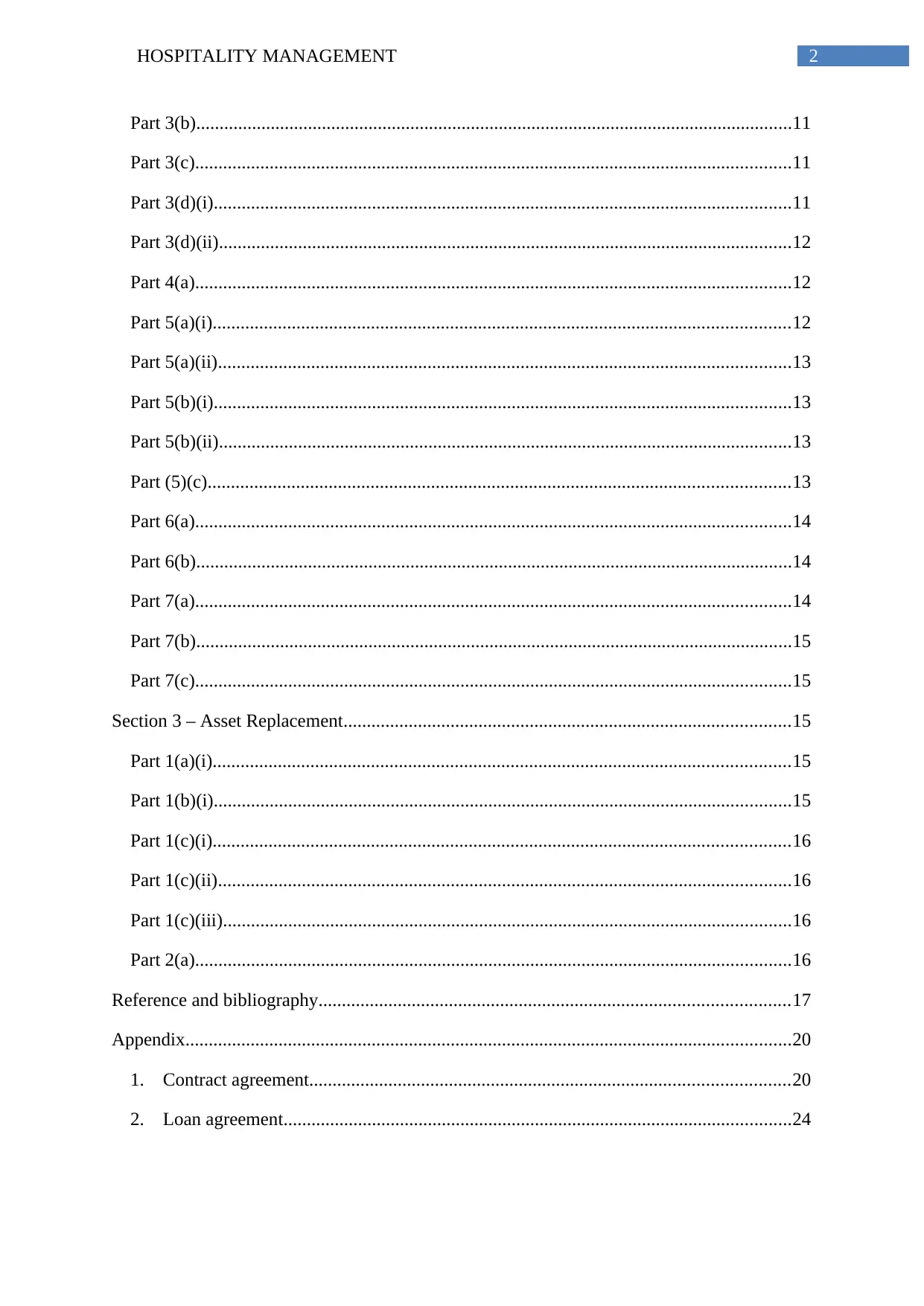
2HOSPITALITY MANAGEMENT
Part 3(b)................................................................................................................................11
Part 3(c)................................................................................................................................11
Part 3(d)(i)............................................................................................................................11
Part 3(d)(ii)...........................................................................................................................12
Part 4(a)................................................................................................................................12
Part 5(a)(i)............................................................................................................................12
Part 5(a)(ii)...........................................................................................................................13
Part 5(b)(i)............................................................................................................................13
Part 5(b)(ii)...........................................................................................................................13
Part (5)(c).............................................................................................................................13
Part 6(a)................................................................................................................................14
Part 6(b)................................................................................................................................14
Part 7(a)................................................................................................................................14
Part 7(b)................................................................................................................................15
Part 7(c)................................................................................................................................15
Section 3 – Asset Replacement................................................................................................15
Part 1(a)(i)............................................................................................................................15
Part 1(b)(i)............................................................................................................................15
Part 1(c)(i)............................................................................................................................16
Part 1(c)(ii)...........................................................................................................................16
Part 1(c)(iii)..........................................................................................................................16
Part 2(a)................................................................................................................................16
Reference and bibliography.....................................................................................................17
Appendix..................................................................................................................................20
1. Contract agreement.......................................................................................................20
2. Loan agreement.............................................................................................................24
Part 3(b)................................................................................................................................11
Part 3(c)................................................................................................................................11
Part 3(d)(i)............................................................................................................................11
Part 3(d)(ii)...........................................................................................................................12
Part 4(a)................................................................................................................................12
Part 5(a)(i)............................................................................................................................12
Part 5(a)(ii)...........................................................................................................................13
Part 5(b)(i)............................................................................................................................13
Part 5(b)(ii)...........................................................................................................................13
Part (5)(c).............................................................................................................................13
Part 6(a)................................................................................................................................14
Part 6(b)................................................................................................................................14
Part 7(a)................................................................................................................................14
Part 7(b)................................................................................................................................15
Part 7(c)................................................................................................................................15
Section 3 – Asset Replacement................................................................................................15
Part 1(a)(i)............................................................................................................................15
Part 1(b)(i)............................................................................................................................15
Part 1(c)(i)............................................................................................................................16
Part 1(c)(ii)...........................................................................................................................16
Part 1(c)(iii)..........................................................................................................................16
Part 2(a)................................................................................................................................16
Reference and bibliography.....................................................................................................17
Appendix..................................................................................................................................20
1. Contract agreement.......................................................................................................20
2. Loan agreement.............................................................................................................24
⊘ This is a preview!⊘
Do you want full access?
Subscribe today to unlock all pages.

Trusted by 1+ million students worldwide

3HOSPITALITY MANAGEMENT
Paraphrase This Document
Need a fresh take? Get an instant paraphrase of this document with our AI Paraphraser
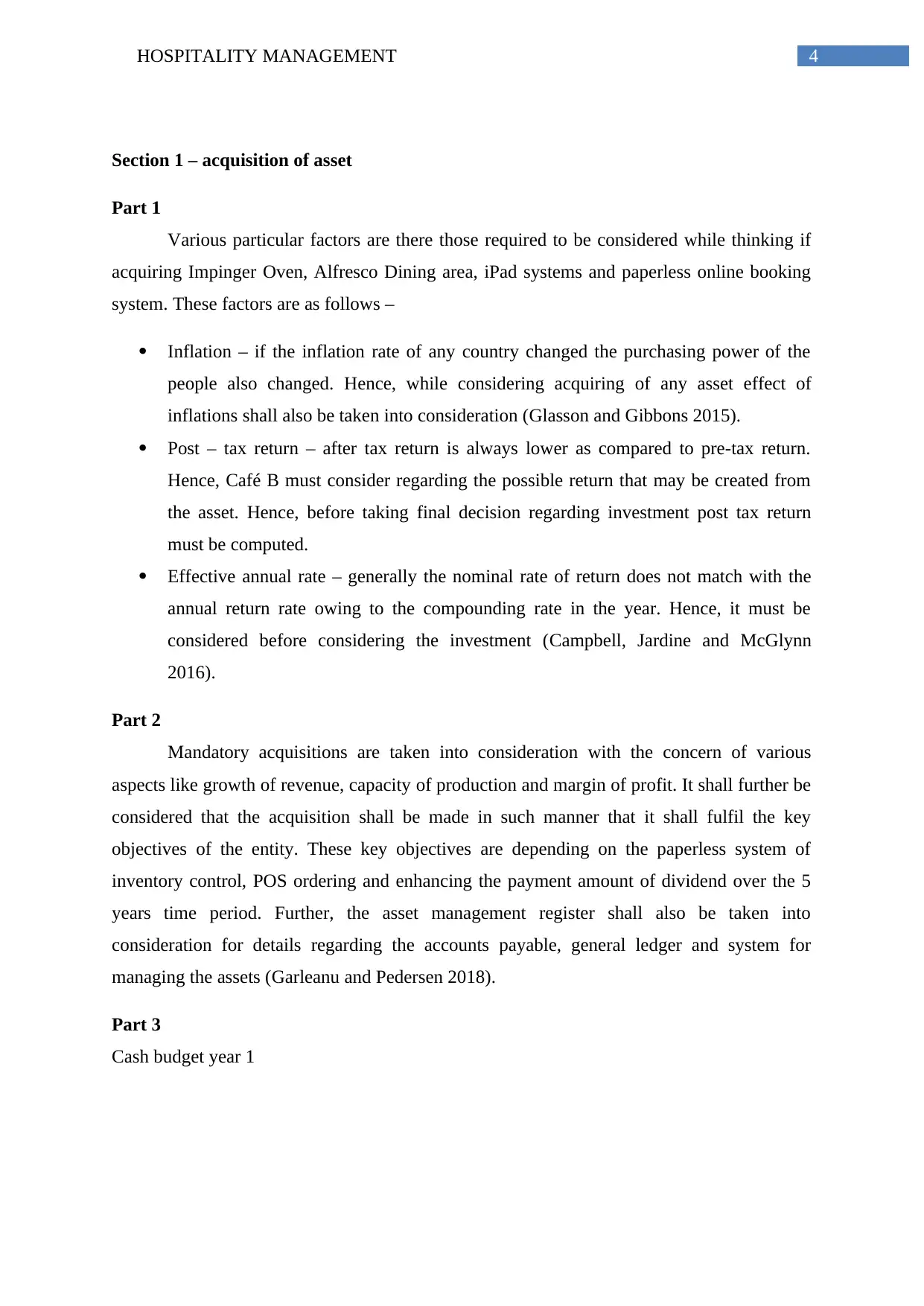
4HOSPITALITY MANAGEMENT
Section 1 – acquisition of asset
Part 1
Various particular factors are there those required to be considered while thinking if
acquiring Impinger Oven, Alfresco Dining area, iPad systems and paperless online booking
system. These factors are as follows –
Inflation – if the inflation rate of any country changed the purchasing power of the
people also changed. Hence, while considering acquiring of any asset effect of
inflations shall also be taken into consideration (Glasson and Gibbons 2015).
Post – tax return – after tax return is always lower as compared to pre-tax return.
Hence, Café B must consider regarding the possible return that may be created from
the asset. Hence, before taking final decision regarding investment post tax return
must be computed.
Effective annual rate – generally the nominal rate of return does not match with the
annual return rate owing to the compounding rate in the year. Hence, it must be
considered before considering the investment (Campbell, Jardine and McGlynn
2016).
Part 2
Mandatory acquisitions are taken into consideration with the concern of various
aspects like growth of revenue, capacity of production and margin of profit. It shall further be
considered that the acquisition shall be made in such manner that it shall fulfil the key
objectives of the entity. These key objectives are depending on the paperless system of
inventory control, POS ordering and enhancing the payment amount of dividend over the 5
years time period. Further, the asset management register shall also be taken into
consideration for details regarding the accounts payable, general ledger and system for
managing the assets (Garleanu and Pedersen 2018).
Part 3
Cash budget year 1
Section 1 – acquisition of asset
Part 1
Various particular factors are there those required to be considered while thinking if
acquiring Impinger Oven, Alfresco Dining area, iPad systems and paperless online booking
system. These factors are as follows –
Inflation – if the inflation rate of any country changed the purchasing power of the
people also changed. Hence, while considering acquiring of any asset effect of
inflations shall also be taken into consideration (Glasson and Gibbons 2015).
Post – tax return – after tax return is always lower as compared to pre-tax return.
Hence, Café B must consider regarding the possible return that may be created from
the asset. Hence, before taking final decision regarding investment post tax return
must be computed.
Effective annual rate – generally the nominal rate of return does not match with the
annual return rate owing to the compounding rate in the year. Hence, it must be
considered before considering the investment (Campbell, Jardine and McGlynn
2016).
Part 2
Mandatory acquisitions are taken into consideration with the concern of various
aspects like growth of revenue, capacity of production and margin of profit. It shall further be
considered that the acquisition shall be made in such manner that it shall fulfil the key
objectives of the entity. These key objectives are depending on the paperless system of
inventory control, POS ordering and enhancing the payment amount of dividend over the 5
years time period. Further, the asset management register shall also be taken into
consideration for details regarding the accounts payable, general ledger and system for
managing the assets (Garleanu and Pedersen 2018).
Part 3
Cash budget year 1

5HOSPITALITY MANAGEMENT
Cash budget year 2
Cash budget year 3
Cash budget year 2
Cash budget year 3
⊘ This is a preview!⊘
Do you want full access?
Subscribe today to unlock all pages.

Trusted by 1+ million students worldwide
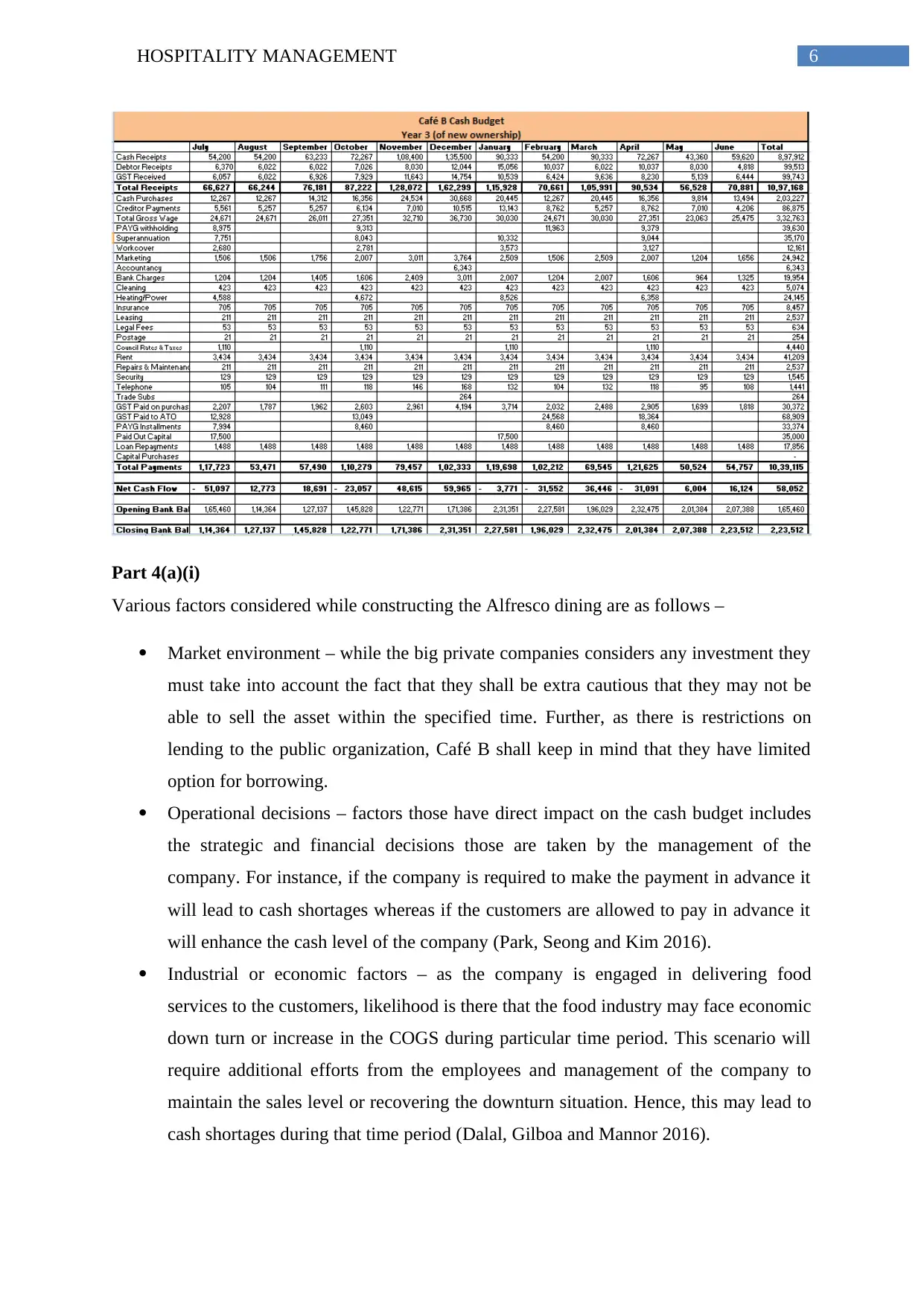
6HOSPITALITY MANAGEMENT
Part 4(a)(i)
Various factors considered while constructing the Alfresco dining are as follows –
Market environment – while the big private companies considers any investment they
must take into account the fact that they shall be extra cautious that they may not be
able to sell the asset within the specified time. Further, as there is restrictions on
lending to the public organization, Café B shall keep in mind that they have limited
option for borrowing.
Operational decisions – factors those have direct impact on the cash budget includes
the strategic and financial decisions those are taken by the management of the
company. For instance, if the company is required to make the payment in advance it
will lead to cash shortages whereas if the customers are allowed to pay in advance it
will enhance the cash level of the company (Park, Seong and Kim 2016).
Industrial or economic factors – as the company is engaged in delivering food
services to the customers, likelihood is there that the food industry may face economic
down turn or increase in the COGS during particular time period. This scenario will
require additional efforts from the employees and management of the company to
maintain the sales level or recovering the downturn situation. Hence, this may lead to
cash shortages during that time period (Dalal, Gilboa and Mannor 2016).
Part 4(a)(i)
Various factors considered while constructing the Alfresco dining are as follows –
Market environment – while the big private companies considers any investment they
must take into account the fact that they shall be extra cautious that they may not be
able to sell the asset within the specified time. Further, as there is restrictions on
lending to the public organization, Café B shall keep in mind that they have limited
option for borrowing.
Operational decisions – factors those have direct impact on the cash budget includes
the strategic and financial decisions those are taken by the management of the
company. For instance, if the company is required to make the payment in advance it
will lead to cash shortages whereas if the customers are allowed to pay in advance it
will enhance the cash level of the company (Park, Seong and Kim 2016).
Industrial or economic factors – as the company is engaged in delivering food
services to the customers, likelihood is there that the food industry may face economic
down turn or increase in the COGS during particular time period. This scenario will
require additional efforts from the employees and management of the company to
maintain the sales level or recovering the downturn situation. Hence, this may lead to
cash shortages during that time period (Dalal, Gilboa and Mannor 2016).
Paraphrase This Document
Need a fresh take? Get an instant paraphrase of this document with our AI Paraphraser
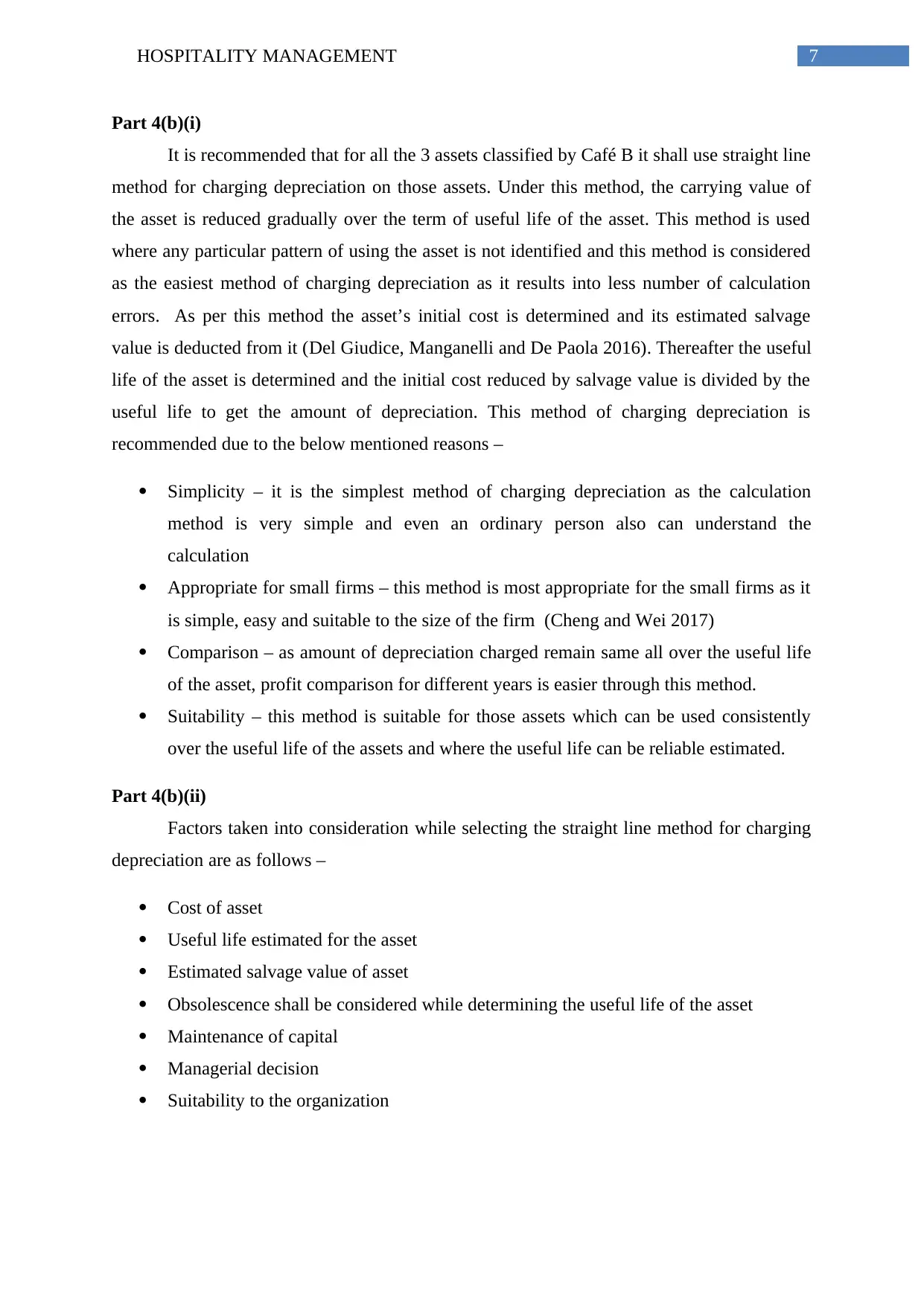
7HOSPITALITY MANAGEMENT
Part 4(b)(i)
It is recommended that for all the 3 assets classified by Café B it shall use straight line
method for charging depreciation on those assets. Under this method, the carrying value of
the asset is reduced gradually over the term of useful life of the asset. This method is used
where any particular pattern of using the asset is not identified and this method is considered
as the easiest method of charging depreciation as it results into less number of calculation
errors. As per this method the asset’s initial cost is determined and its estimated salvage
value is deducted from it (Del Giudice, Manganelli and De Paola 2016). Thereafter the useful
life of the asset is determined and the initial cost reduced by salvage value is divided by the
useful life to get the amount of depreciation. This method of charging depreciation is
recommended due to the below mentioned reasons –
Simplicity – it is the simplest method of charging depreciation as the calculation
method is very simple and even an ordinary person also can understand the
calculation
Appropriate for small firms – this method is most appropriate for the small firms as it
is simple, easy and suitable to the size of the firm (Cheng and Wei 2017)
Comparison – as amount of depreciation charged remain same all over the useful life
of the asset, profit comparison for different years is easier through this method.
Suitability – this method is suitable for those assets which can be used consistently
over the useful life of the assets and where the useful life can be reliable estimated.
Part 4(b)(ii)
Factors taken into consideration while selecting the straight line method for charging
depreciation are as follows –
Cost of asset
Useful life estimated for the asset
Estimated salvage value of asset
Obsolescence shall be considered while determining the useful life of the asset
Maintenance of capital
Managerial decision
Suitability to the organization
Part 4(b)(i)
It is recommended that for all the 3 assets classified by Café B it shall use straight line
method for charging depreciation on those assets. Under this method, the carrying value of
the asset is reduced gradually over the term of useful life of the asset. This method is used
where any particular pattern of using the asset is not identified and this method is considered
as the easiest method of charging depreciation as it results into less number of calculation
errors. As per this method the asset’s initial cost is determined and its estimated salvage
value is deducted from it (Del Giudice, Manganelli and De Paola 2016). Thereafter the useful
life of the asset is determined and the initial cost reduced by salvage value is divided by the
useful life to get the amount of depreciation. This method of charging depreciation is
recommended due to the below mentioned reasons –
Simplicity – it is the simplest method of charging depreciation as the calculation
method is very simple and even an ordinary person also can understand the
calculation
Appropriate for small firms – this method is most appropriate for the small firms as it
is simple, easy and suitable to the size of the firm (Cheng and Wei 2017)
Comparison – as amount of depreciation charged remain same all over the useful life
of the asset, profit comparison for different years is easier through this method.
Suitability – this method is suitable for those assets which can be used consistently
over the useful life of the assets and where the useful life can be reliable estimated.
Part 4(b)(ii)
Factors taken into consideration while selecting the straight line method for charging
depreciation are as follows –
Cost of asset
Useful life estimated for the asset
Estimated salvage value of asset
Obsolescence shall be considered while determining the useful life of the asset
Maintenance of capital
Managerial decision
Suitability to the organization
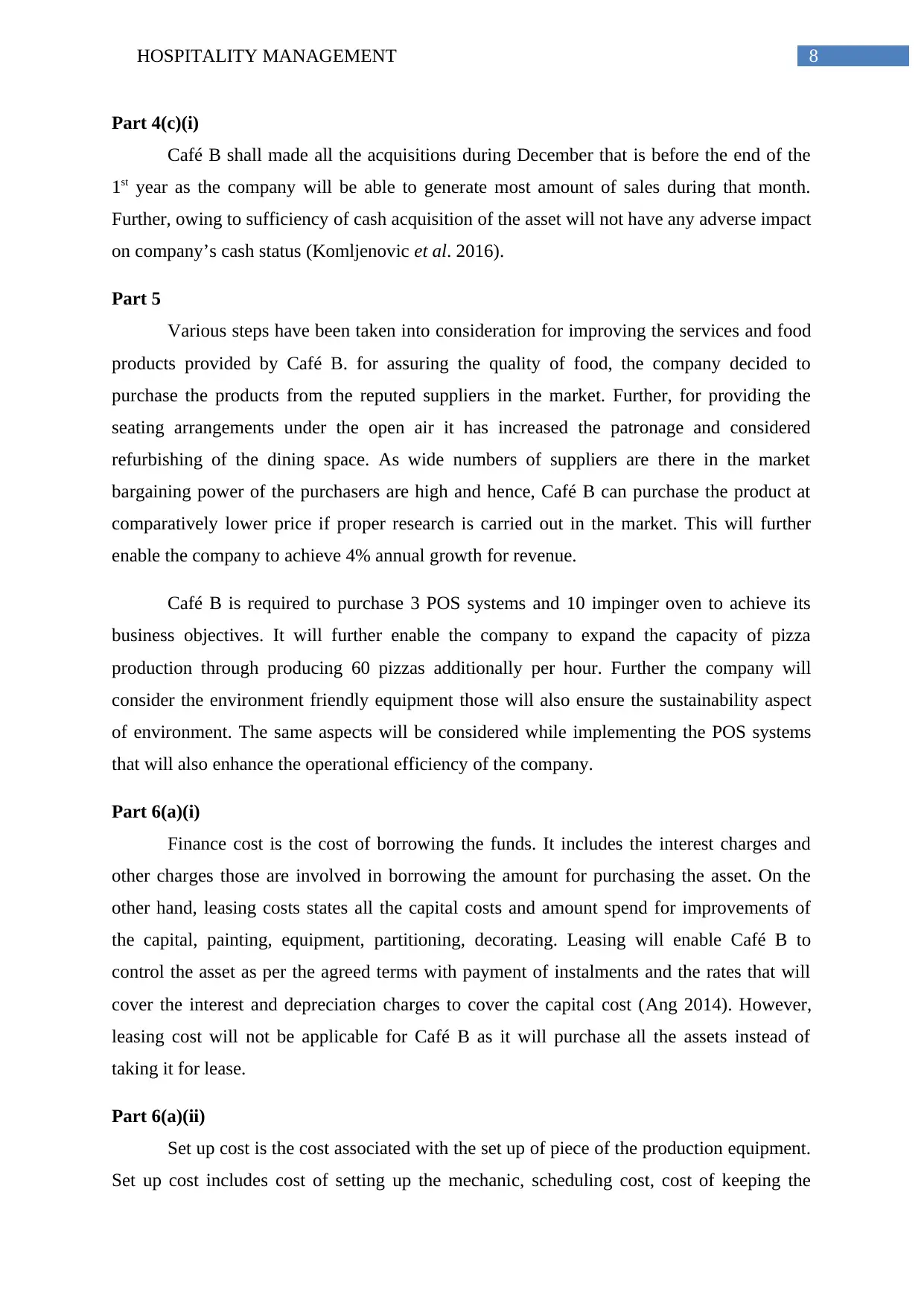
8HOSPITALITY MANAGEMENT
Part 4(c)(i)
Café B shall made all the acquisitions during December that is before the end of the
1st year as the company will be able to generate most amount of sales during that month.
Further, owing to sufficiency of cash acquisition of the asset will not have any adverse impact
on company’s cash status (Komljenovic et al. 2016).
Part 5
Various steps have been taken into consideration for improving the services and food
products provided by Café B. for assuring the quality of food, the company decided to
purchase the products from the reputed suppliers in the market. Further, for providing the
seating arrangements under the open air it has increased the patronage and considered
refurbishing of the dining space. As wide numbers of suppliers are there in the market
bargaining power of the purchasers are high and hence, Café B can purchase the product at
comparatively lower price if proper research is carried out in the market. This will further
enable the company to achieve 4% annual growth for revenue.
Café B is required to purchase 3 POS systems and 10 impinger oven to achieve its
business objectives. It will further enable the company to expand the capacity of pizza
production through producing 60 pizzas additionally per hour. Further the company will
consider the environment friendly equipment those will also ensure the sustainability aspect
of environment. The same aspects will be considered while implementing the POS systems
that will also enhance the operational efficiency of the company.
Part 6(a)(i)
Finance cost is the cost of borrowing the funds. It includes the interest charges and
other charges those are involved in borrowing the amount for purchasing the asset. On the
other hand, leasing costs states all the capital costs and amount spend for improvements of
the capital, painting, equipment, partitioning, decorating. Leasing will enable Café B to
control the asset as per the agreed terms with payment of instalments and the rates that will
cover the interest and depreciation charges to cover the capital cost (Ang 2014). However,
leasing cost will not be applicable for Café B as it will purchase all the assets instead of
taking it for lease.
Part 6(a)(ii)
Set up cost is the cost associated with the set up of piece of the production equipment.
Set up cost includes cost of setting up the mechanic, scheduling cost, cost of keeping the
Part 4(c)(i)
Café B shall made all the acquisitions during December that is before the end of the
1st year as the company will be able to generate most amount of sales during that month.
Further, owing to sufficiency of cash acquisition of the asset will not have any adverse impact
on company’s cash status (Komljenovic et al. 2016).
Part 5
Various steps have been taken into consideration for improving the services and food
products provided by Café B. for assuring the quality of food, the company decided to
purchase the products from the reputed suppliers in the market. Further, for providing the
seating arrangements under the open air it has increased the patronage and considered
refurbishing of the dining space. As wide numbers of suppliers are there in the market
bargaining power of the purchasers are high and hence, Café B can purchase the product at
comparatively lower price if proper research is carried out in the market. This will further
enable the company to achieve 4% annual growth for revenue.
Café B is required to purchase 3 POS systems and 10 impinger oven to achieve its
business objectives. It will further enable the company to expand the capacity of pizza
production through producing 60 pizzas additionally per hour. Further the company will
consider the environment friendly equipment those will also ensure the sustainability aspect
of environment. The same aspects will be considered while implementing the POS systems
that will also enhance the operational efficiency of the company.
Part 6(a)(i)
Finance cost is the cost of borrowing the funds. It includes the interest charges and
other charges those are involved in borrowing the amount for purchasing the asset. On the
other hand, leasing costs states all the capital costs and amount spend for improvements of
the capital, painting, equipment, partitioning, decorating. Leasing will enable Café B to
control the asset as per the agreed terms with payment of instalments and the rates that will
cover the interest and depreciation charges to cover the capital cost (Ang 2014). However,
leasing cost will not be applicable for Café B as it will purchase all the assets instead of
taking it for lease.
Part 6(a)(ii)
Set up cost is the cost associated with the set up of piece of the production equipment.
Set up cost includes cost of setting up the mechanic, scheduling cost, cost of keeping the
⊘ This is a preview!⊘
Do you want full access?
Subscribe today to unlock all pages.

Trusted by 1+ million students worldwide
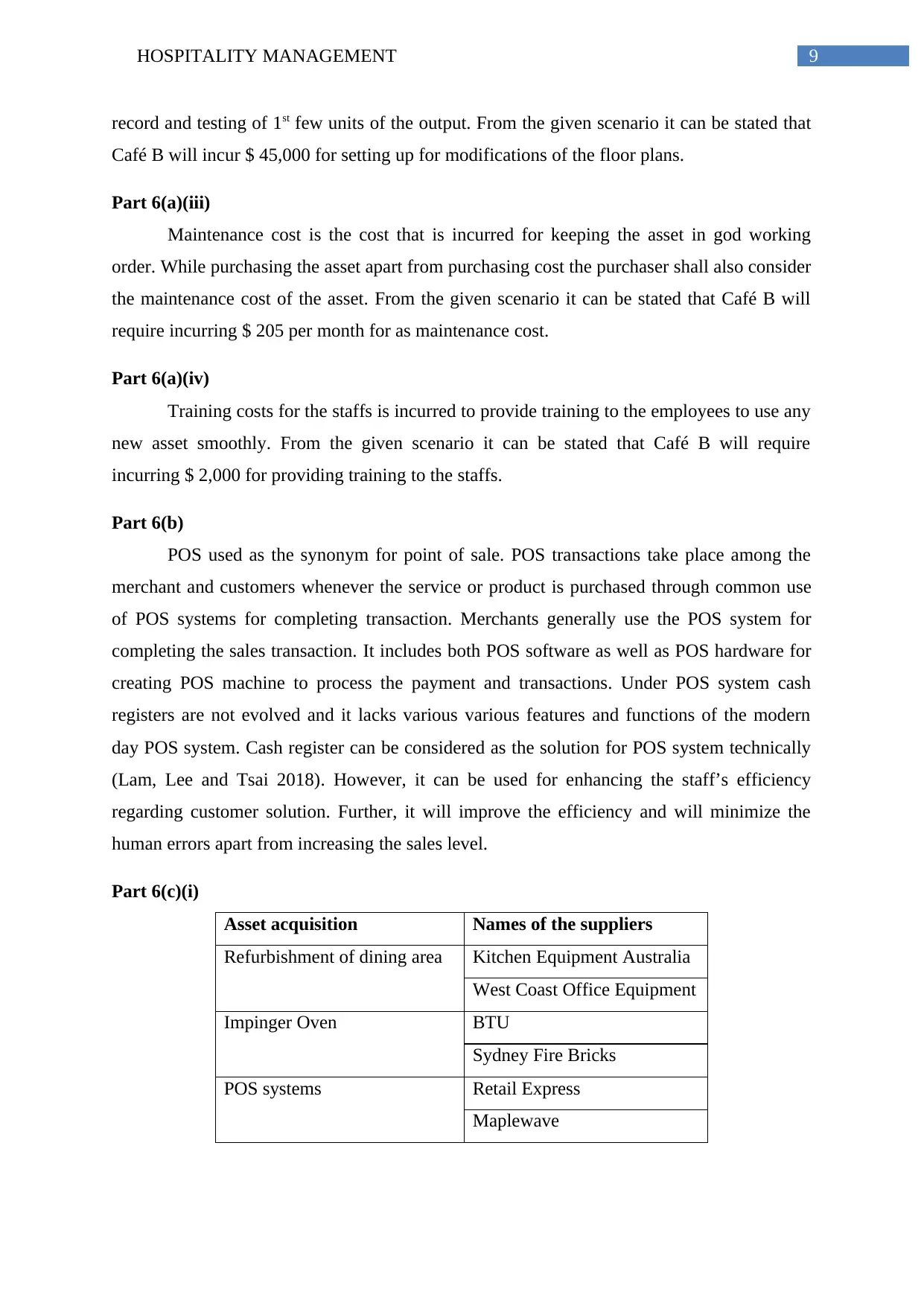
9HOSPITALITY MANAGEMENT
record and testing of 1st few units of the output. From the given scenario it can be stated that
Café B will incur $ 45,000 for setting up for modifications of the floor plans.
Part 6(a)(iii)
Maintenance cost is the cost that is incurred for keeping the asset in god working
order. While purchasing the asset apart from purchasing cost the purchaser shall also consider
the maintenance cost of the asset. From the given scenario it can be stated that Café B will
require incurring $ 205 per month for as maintenance cost.
Part 6(a)(iv)
Training costs for the staffs is incurred to provide training to the employees to use any
new asset smoothly. From the given scenario it can be stated that Café B will require
incurring $ 2,000 for providing training to the staffs.
Part 6(b)
POS used as the synonym for point of sale. POS transactions take place among the
merchant and customers whenever the service or product is purchased through common use
of POS systems for completing transaction. Merchants generally use the POS system for
completing the sales transaction. It includes both POS software as well as POS hardware for
creating POS machine to process the payment and transactions. Under POS system cash
registers are not evolved and it lacks various various features and functions of the modern
day POS system. Cash register can be considered as the solution for POS system technically
(Lam, Lee and Tsai 2018). However, it can be used for enhancing the staff’s efficiency
regarding customer solution. Further, it will improve the efficiency and will minimize the
human errors apart from increasing the sales level.
Part 6(c)(i)
Asset acquisition Names of the suppliers
Refurbishment of dining area Kitchen Equipment Australia
West Coast Office Equipment
Impinger Oven BTU
Sydney Fire Bricks
POS systems Retail Express
Maplewave
record and testing of 1st few units of the output. From the given scenario it can be stated that
Café B will incur $ 45,000 for setting up for modifications of the floor plans.
Part 6(a)(iii)
Maintenance cost is the cost that is incurred for keeping the asset in god working
order. While purchasing the asset apart from purchasing cost the purchaser shall also consider
the maintenance cost of the asset. From the given scenario it can be stated that Café B will
require incurring $ 205 per month for as maintenance cost.
Part 6(a)(iv)
Training costs for the staffs is incurred to provide training to the employees to use any
new asset smoothly. From the given scenario it can be stated that Café B will require
incurring $ 2,000 for providing training to the staffs.
Part 6(b)
POS used as the synonym for point of sale. POS transactions take place among the
merchant and customers whenever the service or product is purchased through common use
of POS systems for completing transaction. Merchants generally use the POS system for
completing the sales transaction. It includes both POS software as well as POS hardware for
creating POS machine to process the payment and transactions. Under POS system cash
registers are not evolved and it lacks various various features and functions of the modern
day POS system. Cash register can be considered as the solution for POS system technically
(Lam, Lee and Tsai 2018). However, it can be used for enhancing the staff’s efficiency
regarding customer solution. Further, it will improve the efficiency and will minimize the
human errors apart from increasing the sales level.
Part 6(c)(i)
Asset acquisition Names of the suppliers
Refurbishment of dining area Kitchen Equipment Australia
West Coast Office Equipment
Impinger Oven BTU
Sydney Fire Bricks
POS systems Retail Express
Maplewave
Paraphrase This Document
Need a fresh take? Get an instant paraphrase of this document with our AI Paraphraser
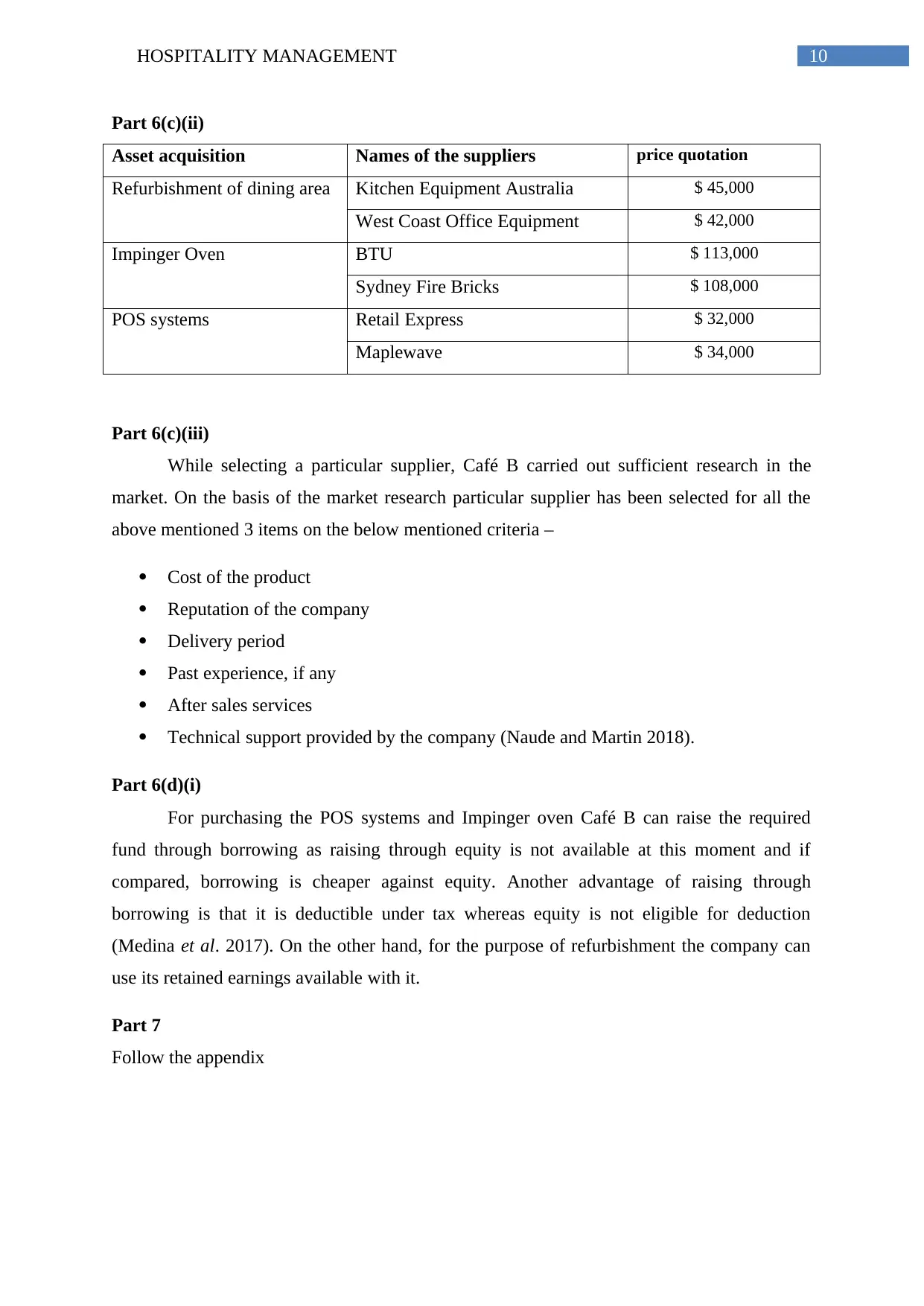
10HOSPITALITY MANAGEMENT
Part 6(c)(ii)
Asset acquisition Names of the suppliers price quotation
Refurbishment of dining area Kitchen Equipment Australia $ 45,000
West Coast Office Equipment $ 42,000
Impinger Oven BTU $ 113,000
Sydney Fire Bricks $ 108,000
POS systems Retail Express $ 32,000
Maplewave $ 34,000
Part 6(c)(iii)
While selecting a particular supplier, Café B carried out sufficient research in the
market. On the basis of the market research particular supplier has been selected for all the
above mentioned 3 items on the below mentioned criteria –
Cost of the product
Reputation of the company
Delivery period
Past experience, if any
After sales services
Technical support provided by the company (Naude and Martin 2018).
Part 6(d)(i)
For purchasing the POS systems and Impinger oven Café B can raise the required
fund through borrowing as raising through equity is not available at this moment and if
compared, borrowing is cheaper against equity. Another advantage of raising through
borrowing is that it is deductible under tax whereas equity is not eligible for deduction
(Medina et al. 2017). On the other hand, for the purpose of refurbishment the company can
use its retained earnings available with it.
Part 7
Follow the appendix
Part 6(c)(ii)
Asset acquisition Names of the suppliers price quotation
Refurbishment of dining area Kitchen Equipment Australia $ 45,000
West Coast Office Equipment $ 42,000
Impinger Oven BTU $ 113,000
Sydney Fire Bricks $ 108,000
POS systems Retail Express $ 32,000
Maplewave $ 34,000
Part 6(c)(iii)
While selecting a particular supplier, Café B carried out sufficient research in the
market. On the basis of the market research particular supplier has been selected for all the
above mentioned 3 items on the below mentioned criteria –
Cost of the product
Reputation of the company
Delivery period
Past experience, if any
After sales services
Technical support provided by the company (Naude and Martin 2018).
Part 6(d)(i)
For purchasing the POS systems and Impinger oven Café B can raise the required
fund through borrowing as raising through equity is not available at this moment and if
compared, borrowing is cheaper against equity. Another advantage of raising through
borrowing is that it is deductible under tax whereas equity is not eligible for deduction
(Medina et al. 2017). On the other hand, for the purpose of refurbishment the company can
use its retained earnings available with it.
Part 7
Follow the appendix
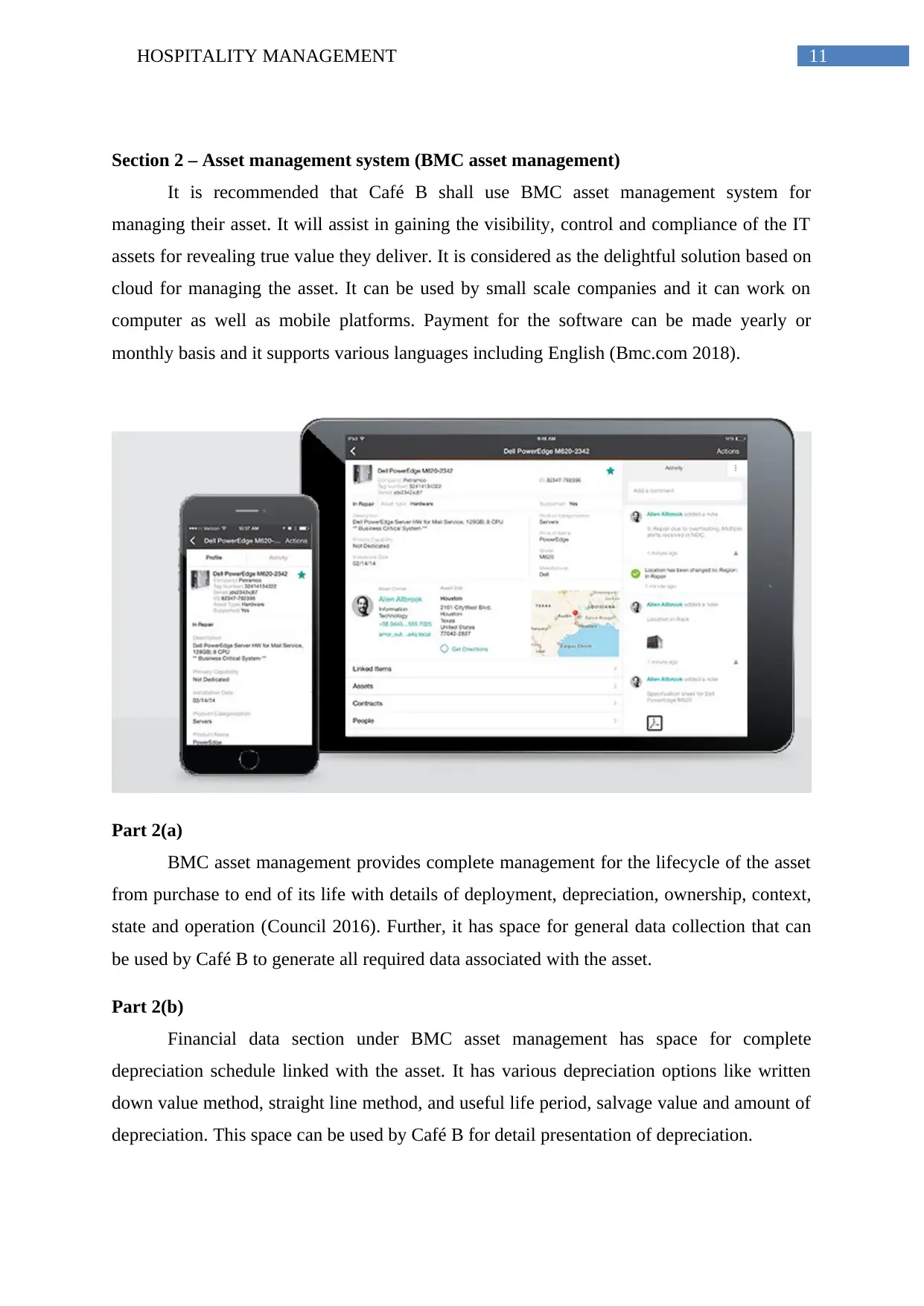
11HOSPITALITY MANAGEMENT
Section 2 – Asset management system (BMC asset management)
It is recommended that Café B shall use BMC asset management system for
managing their asset. It will assist in gaining the visibility, control and compliance of the IT
assets for revealing true value they deliver. It is considered as the delightful solution based on
cloud for managing the asset. It can be used by small scale companies and it can work on
computer as well as mobile platforms. Payment for the software can be made yearly or
monthly basis and it supports various languages including English (Bmc.com 2018).
Part 2(a)
BMC asset management provides complete management for the lifecycle of the asset
from purchase to end of its life with details of deployment, depreciation, ownership, context,
state and operation (Council 2016). Further, it has space for general data collection that can
be used by Café B to generate all required data associated with the asset.
Part 2(b)
Financial data section under BMC asset management has space for complete
depreciation schedule linked with the asset. It has various depreciation options like written
down value method, straight line method, and useful life period, salvage value and amount of
depreciation. This space can be used by Café B for detail presentation of depreciation.
Section 2 – Asset management system (BMC asset management)
It is recommended that Café B shall use BMC asset management system for
managing their asset. It will assist in gaining the visibility, control and compliance of the IT
assets for revealing true value they deliver. It is considered as the delightful solution based on
cloud for managing the asset. It can be used by small scale companies and it can work on
computer as well as mobile platforms. Payment for the software can be made yearly or
monthly basis and it supports various languages including English (Bmc.com 2018).
Part 2(a)
BMC asset management provides complete management for the lifecycle of the asset
from purchase to end of its life with details of deployment, depreciation, ownership, context,
state and operation (Council 2016). Further, it has space for general data collection that can
be used by Café B to generate all required data associated with the asset.
Part 2(b)
Financial data section under BMC asset management has space for complete
depreciation schedule linked with the asset. It has various depreciation options like written
down value method, straight line method, and useful life period, salvage value and amount of
depreciation. This space can be used by Café B for detail presentation of depreciation.
⊘ This is a preview!⊘
Do you want full access?
Subscribe today to unlock all pages.

Trusted by 1+ million students worldwide
1 out of 29
Related Documents
Your All-in-One AI-Powered Toolkit for Academic Success.
+13062052269
info@desklib.com
Available 24*7 on WhatsApp / Email
![[object Object]](/_next/static/media/star-bottom.7253800d.svg)
Unlock your academic potential
Copyright © 2020–2025 A2Z Services. All Rights Reserved. Developed and managed by ZUCOL.




